|
|

|
Porsche, and the Porsche crest are registered trademarks of Dr. Ing. h.c. F. Porsche AG.
This site is not affiliated with Porsche in any way. Its only purpose is to provide an online forum for car enthusiasts. All other trademarks are property of their respective owners. |
|
|
| Eric_Shea |
 Jun 14 2008, 12:23 AM Jun 14 2008, 12:23 AM
Post
#1
|
|
PMB Performance                Group: Admin Posts: 19,299 Joined: 3-September 03 From: Salt Lake City, UT Member No.: 1,110 Region Association: Rocky Mountains  |
Dave Pateman sent some S-Calipers down for a dichromate re-do (not these in the thread, a later pair off a 73+ car) and he graciously sent an odd-ball caliper he had laying around for me to have a look at.
It sure proved interesting and, I have my "theory(s)" as to what it is and how it, and the following S-Caliper lineage came to be. The theory goes like this: Porsche has been well documented in proving a concept at the track and then positioning that concept on their production line vehicles. I believe that ATE was commissioned to make a lighter caliper for their racing vehicles. I believe what we're about to see is one of the first basic S-Calipers to exist. On with a tale of two S-Calipers: 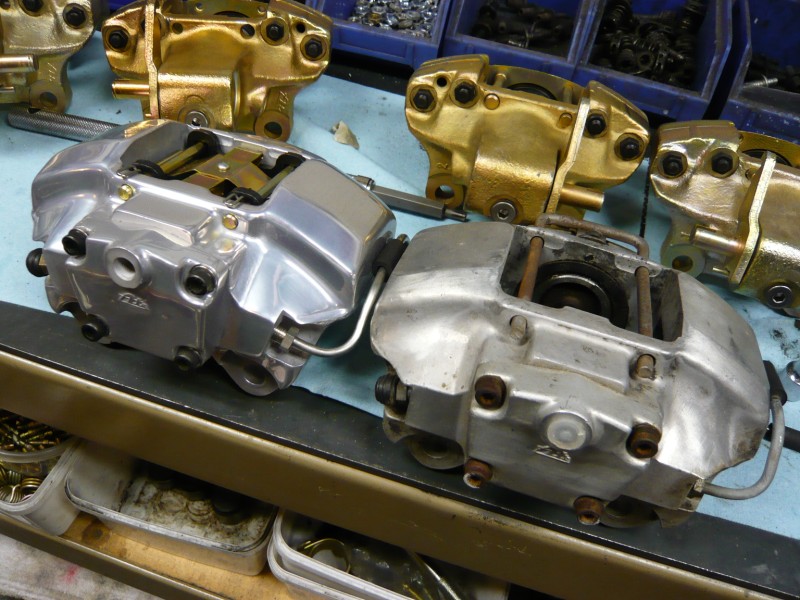 Mine's on the left. It's a reconditioned, very early (69-70) S-Caliper that I will be using on my GT car. Dave's one-off is on the right. The first glaringly obvious difference is the endurance pad pin assembly. Any car that is going to go through S-Caliper pads in a single race is probably going at it for 24 hours. 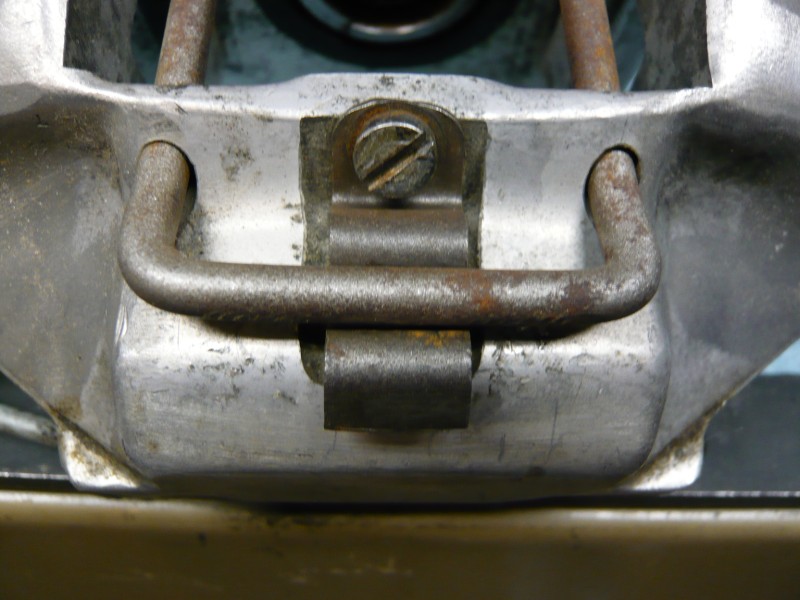 Upon further inspection, this caliper was finish machined slightly different as well. The tops were flattened but only by a small amount. Various logos and markings are not in the usual production locations and there's a few "niceties" that would be missing. I'll try to cover it all herein. First let's look at the bottom side logos. Both are "basically" in the same place but, the casting lines from the production caliper (red arrow) is missing and the logo is centered (refinishers buffed the other logo a tad much): 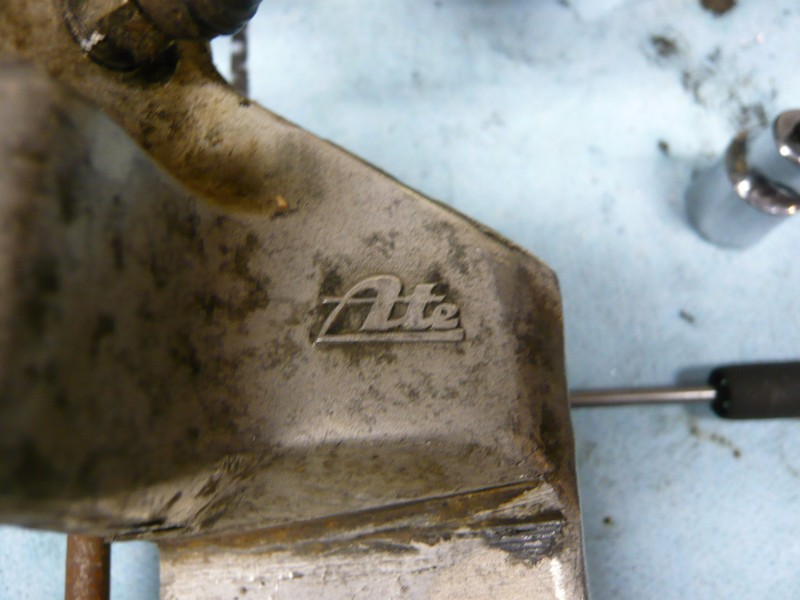 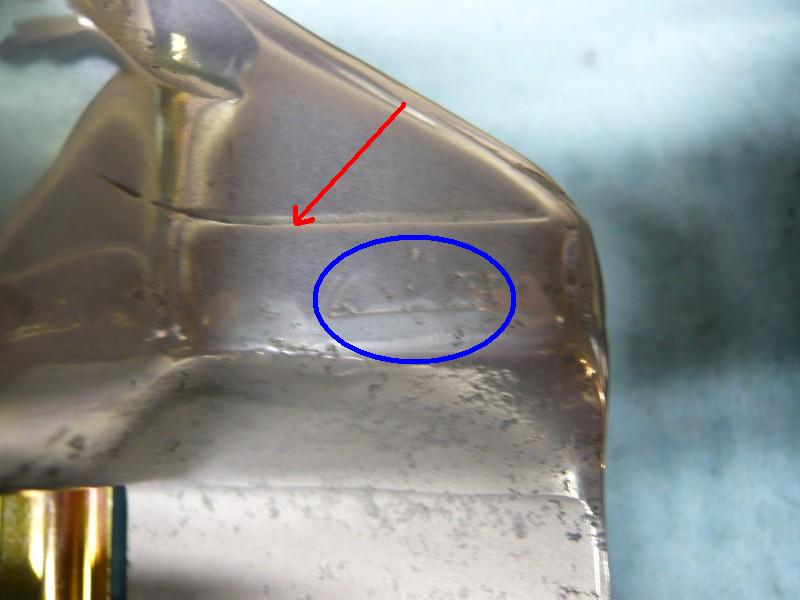 The flute around the pad cavity is slightly different. These calipers are nearly identical with the exception of some of these things which lead me to believe a later production model was molded off the same casting. The later flute is slightly deeper: 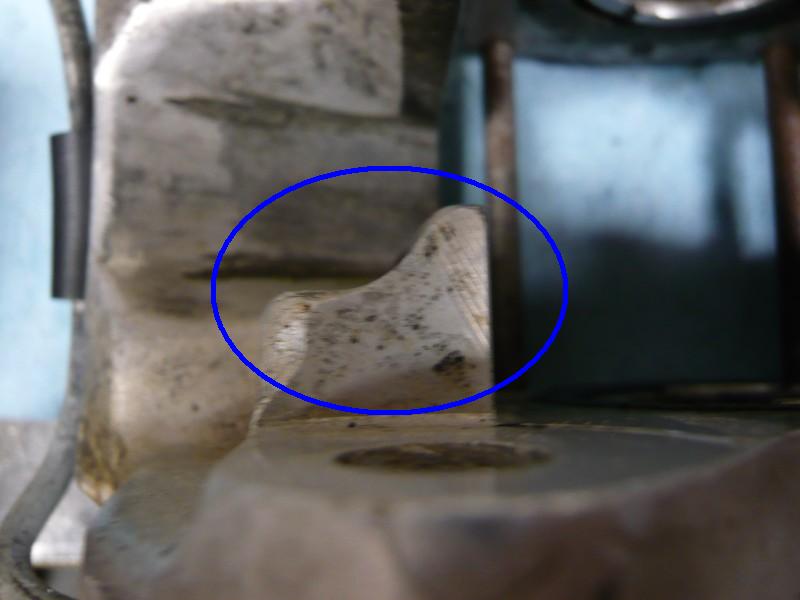 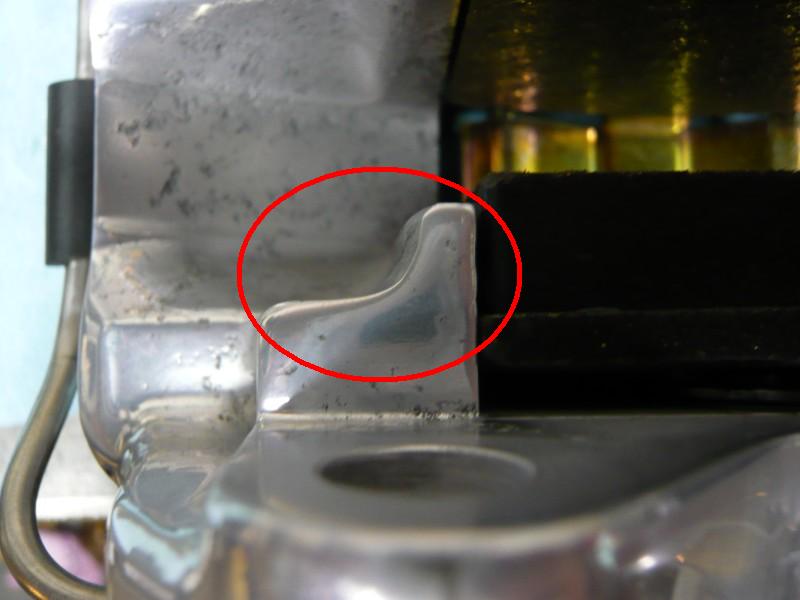 Again, markings and castings are slightly different. I do not believe the 68 represents a year. Mine have similar markings elsewhere on the caliper and they're something like 33. I would guess a finisher stamp?? 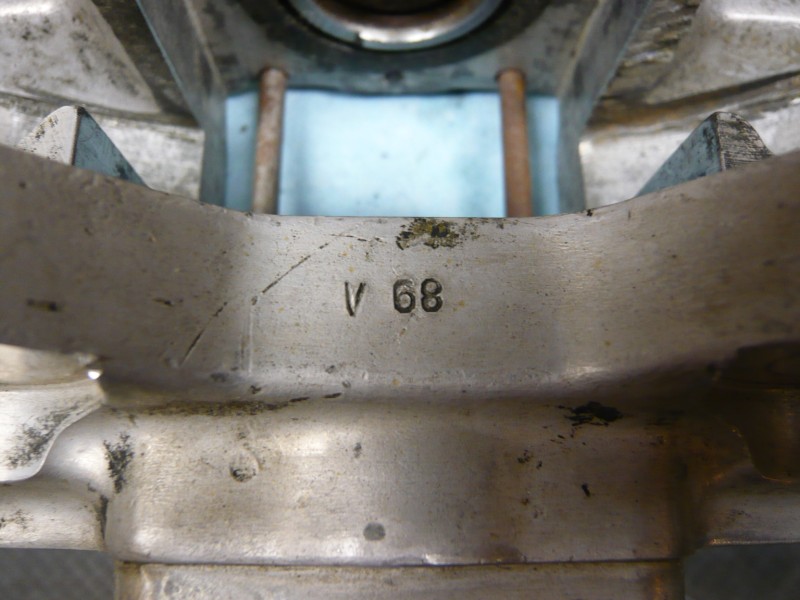 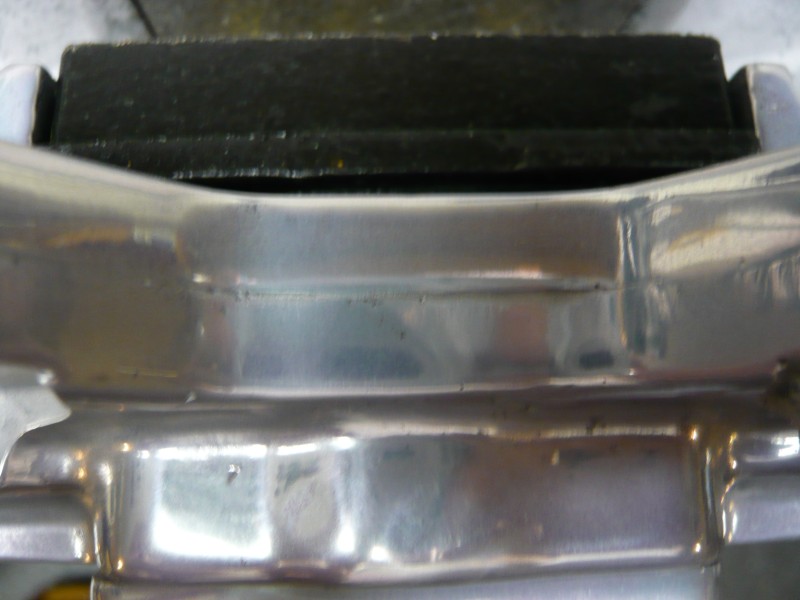 Here's one of the convenience things or "niceties" I found. It's a pain in the @$$ to get S-Caliper lines and bleeders off. These must have been a bear. Note how the later production model caliper differs: 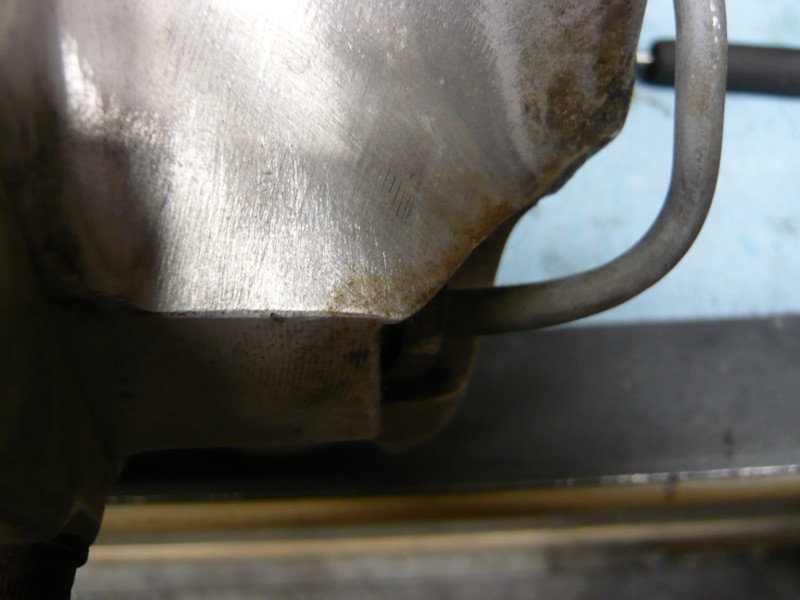 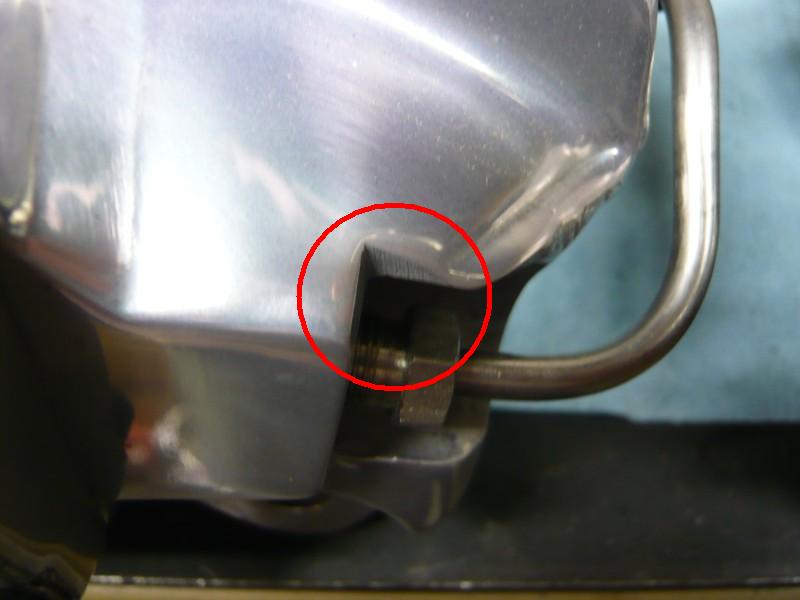 This stamping on the machined top tells me this was no afterthought to make it fit a certain wheel. The race dept. probably worked closely with ATE for these specs.: 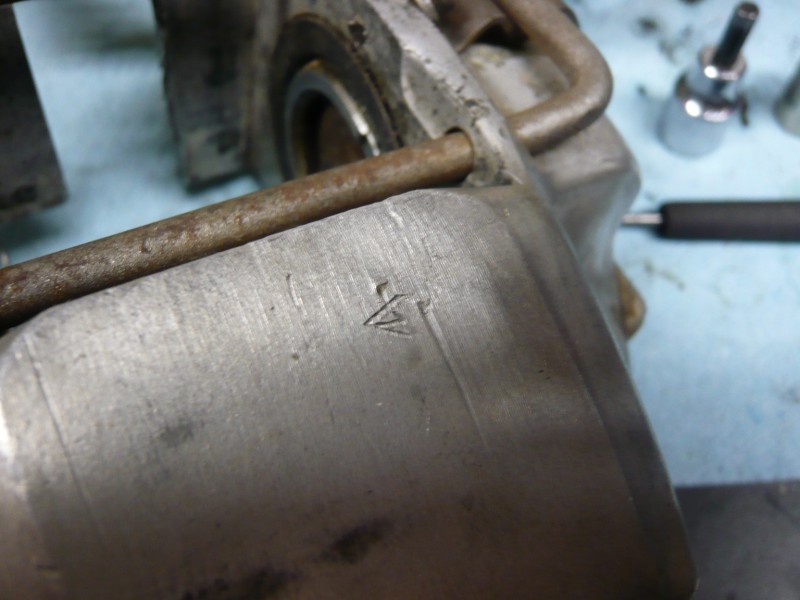 Here's the two side by side. Again, proportionately these calipers are identical. You can see how they finished the top on this caliper: 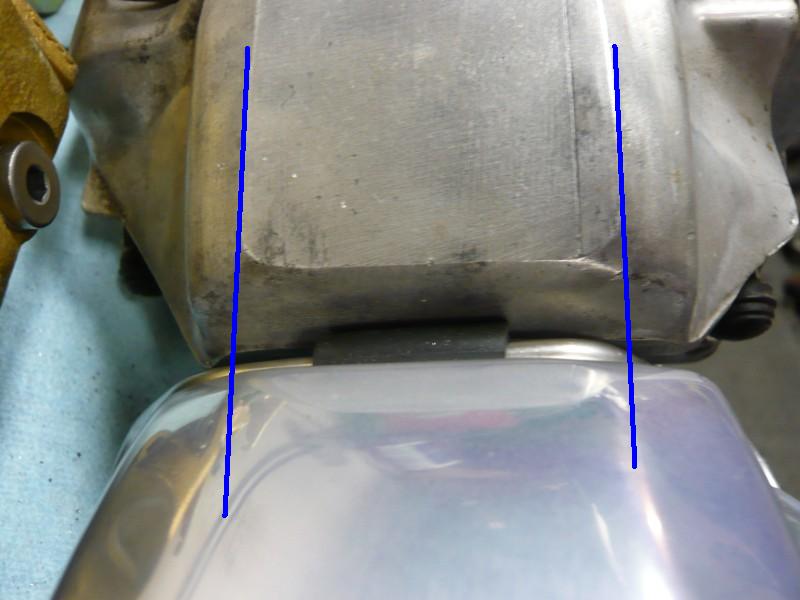 On the side of the nose of the caliper there's an odd bump, possibly denoting the back of the piston chamber. The production model bump is more pronounced: 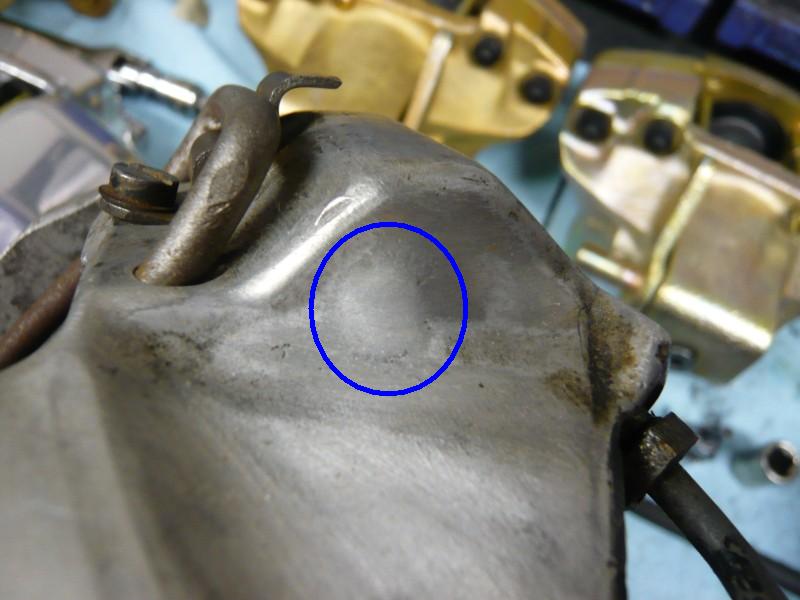 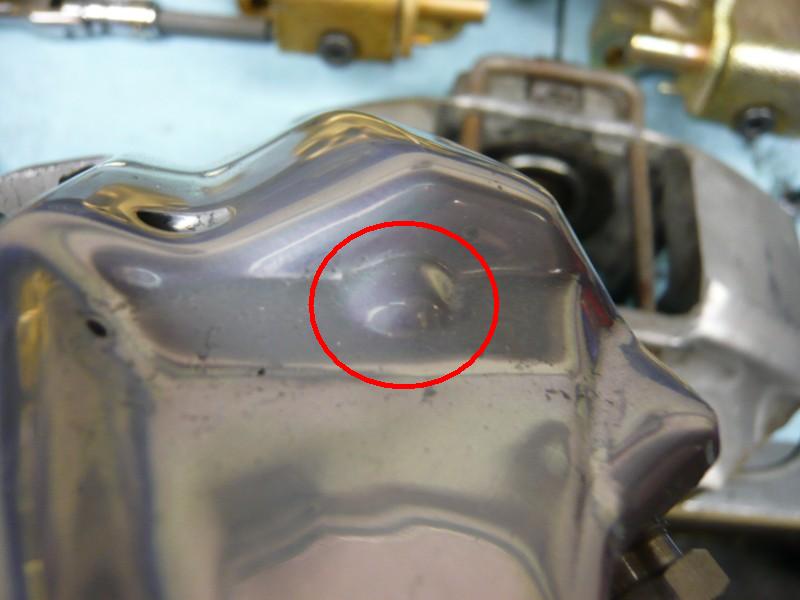 Here's a little more detail on the quick-change endurance pad pin. While this was a rather crude adaptation to the original caliper, I do believe it falls right in line with a factory race look and feel. I'm fairly certain this was an original mod.: 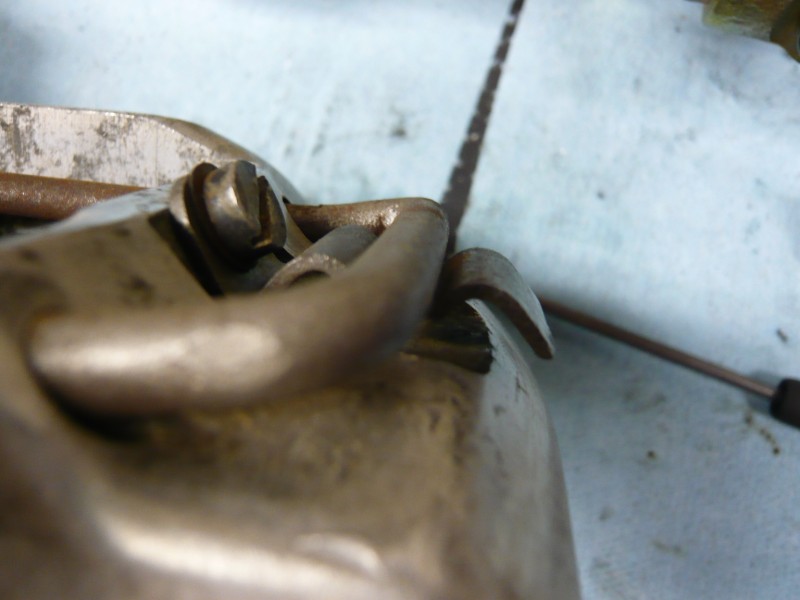 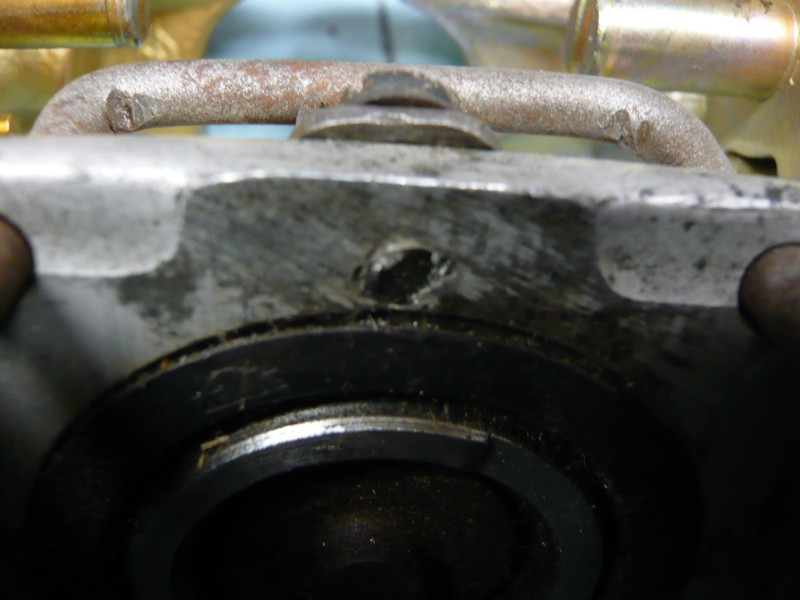 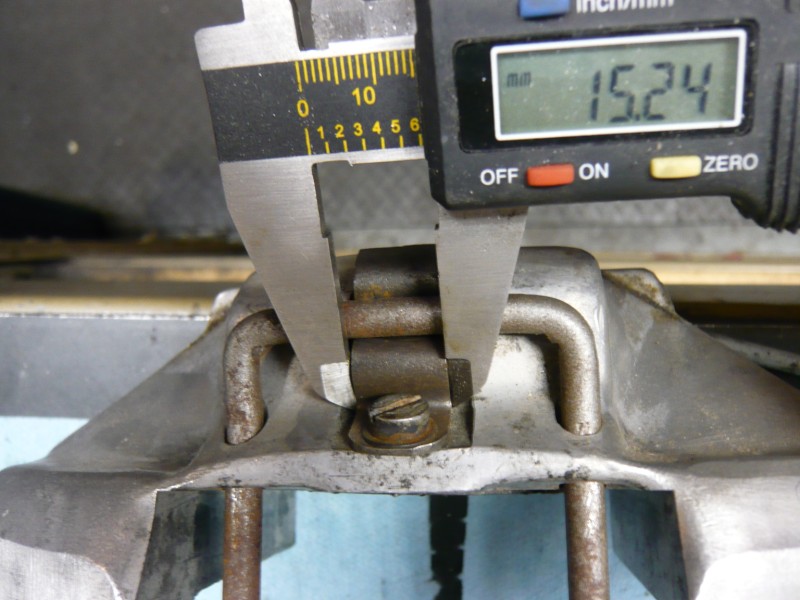 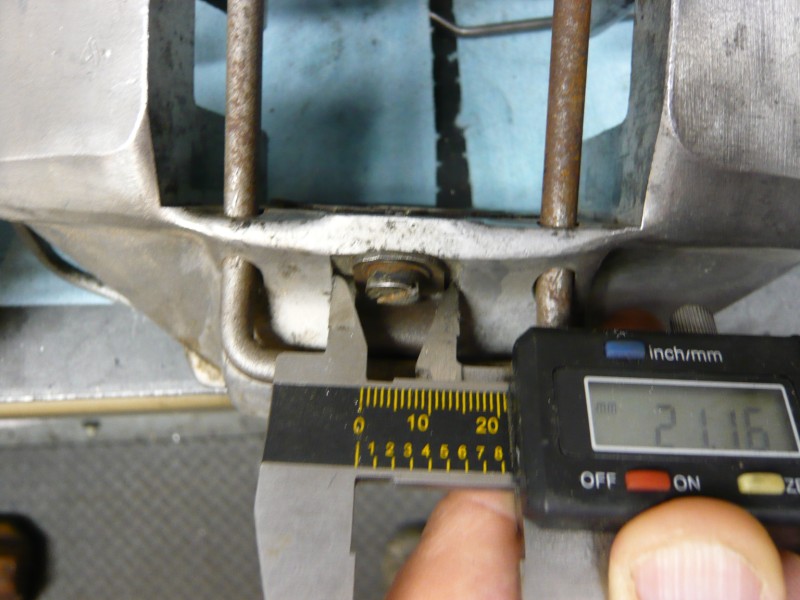 Pistons are different. The one-off has a very deep piston top. The standard S-Caliper piston is pictured in-hand: 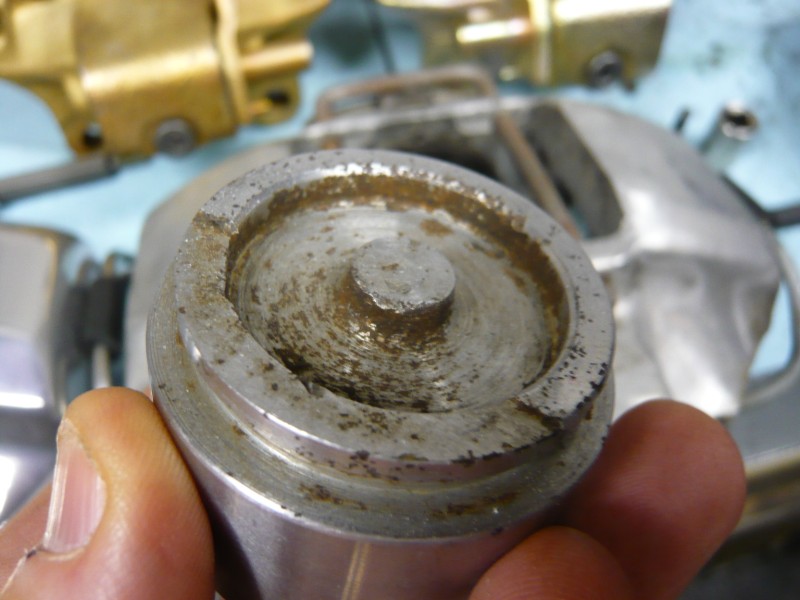 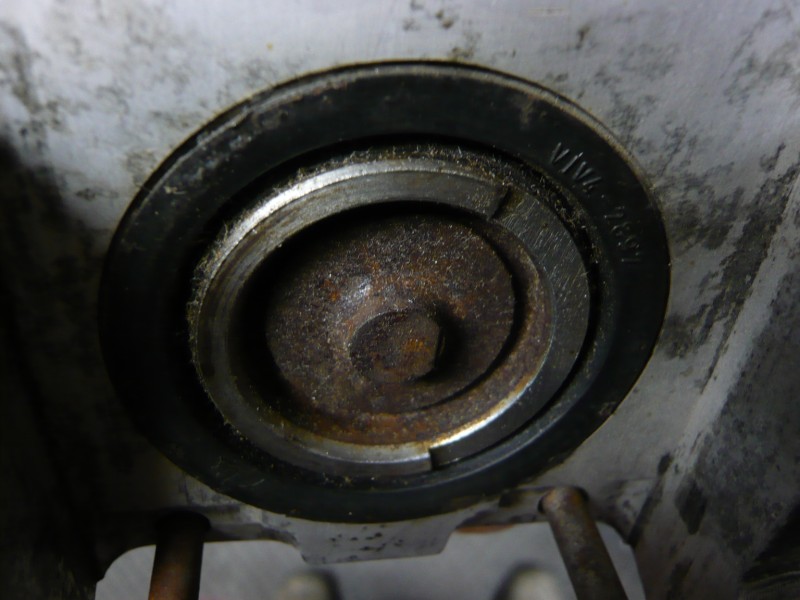 The pin assembly itself is rather crude and not even but again I think this is a factory manifestation. I've seen these pins on one other set of calipers but without the latch mechanism. All in all, it was an interesting afternoon (for me anyway). Here's a full-on shot of both calipers (pay no attention to the two pair of original GT calipers in the background!): 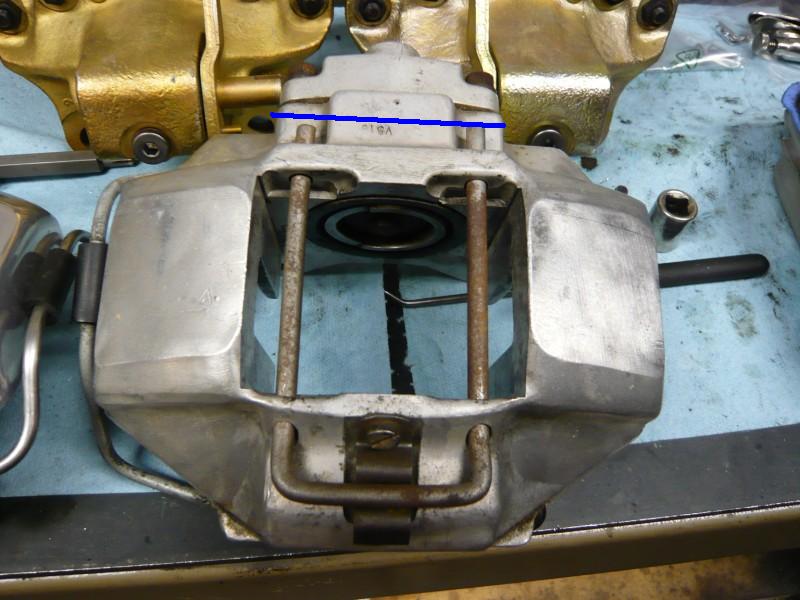 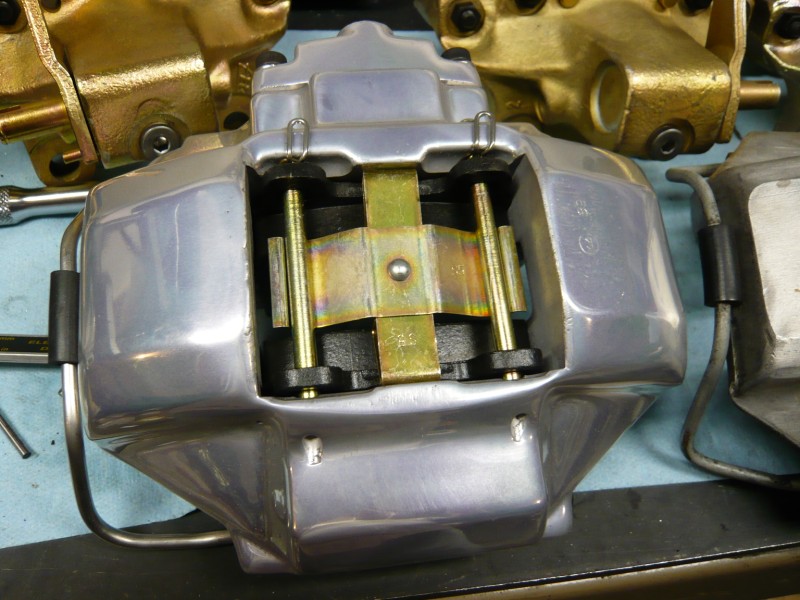 What are your thoughts? |
  |
Replies
| davep |
 Jun 20 2008, 04:05 PM Jun 20 2008, 04:05 PM
Post
#2
|
|
914 Historian      Group: Benefactors Posts: 5,255 Joined: 13-October 03 From: Burford, ON, N0E 1A0 Member No.: 1,244 Region Association: Canada  |
here is an interesting thread I came across in my research:
http://forums.pelicanparts.com/showthread.php?t=169568 I have a few emails out to the fellows involved trying to learn more. It would appear that the caliper evolved from the 910 style with the round back cover to the more familiar S caliper. Varieties of the caliper were made to suit particular applications. The most familiar 908 variety with the bottom pins and plate was an endurance caliper with thicker pads. However the single pin for pad release seems to stick out quite a bit, and may not be suitable for rims less than 15" diameter. My caliper is shaved down and would fit smaller rims better. Therefore I think we need to look at cars that used the smaller rims. |
| Jeff Hail |
 Jun 21 2008, 01:32 AM Jun 21 2008, 01:32 AM
Post
#3
|
|
Senior Member    Group: Members Posts: 1,141 Joined: 3-May 07 From: LA/ CA Member No.: 7,712 |
here is an interesting thread I came across in my research: http://forums.pelicanparts.com/showthread.php?t=169568 I have a few emails out to the fellows involved trying to learn more. It would appear that the caliper evolved from the 910 style with the round back cover to the more familiar S caliper. Varieties of the caliper were made to suit particular applications. The most familiar 908 variety with the bottom pins and plate was an endurance caliper with thicker pads. However the single pin for pad release seems to stick out quite a bit, and may not be suitable for rims less than 15" diameter. My caliper is shaved down and would fit smaller rims better. Therefore I think we need to look at cars that used the smaller rims. Going back to my original post.........Hans Metzger of Porsche typed model 906/2000 which was known as the Ollon-Spyder. This model first appeared at the Swiss Ollon-Villars hillclimb event. Metzger took inspiration from the Elva-Porsche. This model used exclusivly 13 inch front wheels. Porsche at the time did not make 13 inch wheels and had them produced from an outside source along with revamped uprights. The original wheels were steel would have had a barrel thickness of approx 1/4 an inch. This would have meant shaving any parts including calipers to clear the new wheels. The steel wheels used a reinforced center section extending into the barrel shell requiring even more clearance. The calipers at the time would have to have been experimental or cast and machined for the smaller wheels. As well as the prototypes class (called group 6) aimed at the big manufacturers they also defined a class for competition sports cars (class 4) where a minimum production number of 50 cars was permitted. Piech saw an opportunity in the new ruling, but was convinced that Porsche would need a completely new chassis and car. He decided to use the Ollons-Villar spaceframe chassis (not the 904) as a starting point. The 906 (or Carrera 6) used both steel wheels and magnesium. Applications included 13 inch wheels for up to 2.0 liter versions. The Daytona running 910 also used 13 inch wheels and would have had to use the early shaved calipers. The long tails had brake cooling issues and were than updated with 4 piston calipers and ducts to alleviate cooling problems at the high speed course's. In late 1968 some calipers were updated again to magnesium bodies from the previous aluminum versions for weight savings. Porsche returned to aluminum calipers as the magnesium versions had problems associated with high heat. Even later updates on the 908 and then 907's all wheels were updated to 15 inch. This allowed the use of larger calipers and ventilated brakes to be utilized. The 908 with updated wheels and calipers stopped better than any other previous racing Porsche. Based on the factory documentation and Erics' information the timeline is narrowed even more on Dave's caliper. Based on the inspection marks I honestly believe he has a real Mccoy 908 racing caliper and not one that appeared on a 914 GT as off the shelf racing parts. Adding Porsche has always used the 20% safety margin (or over-build) on it's racing parts unless unavoidable. I cannot see a logical reason for the factory to shave calipers unless it was for smaller diameter wheels. The factory never skimped on brakes. The 907 units used entirely different calipers and then that eventually evolved into the 917 model. |
Posts in this topic
 Eric_Shea The Very First S-Caliper? Jun 14 2008, 12:23 AM
Eric_Shea The Very First S-Caliper? Jun 14 2008, 12:23 AM
 Jeff Hail
What are your thoughts?
I know exactly what the... Jun 14 2008, 03:19 AM
Jeff Hail
What are your thoughts?
I know exactly what the... Jun 14 2008, 03:19 AM
 914Sixer Porsche was always making upgrades and small chang... Jun 14 2008, 07:00 AM
914Sixer Porsche was always making upgrades and small chang... Jun 14 2008, 07:00 AM
 URY914 Eric,
I got a whole box of those calipers. I boug... Jun 14 2008, 08:34 AM
URY914 Eric,
I got a whole box of those calipers. I boug... Jun 14 2008, 08:34 AM
 davep I have had this caliper for about 20 years, and kn... Jun 14 2008, 09:27 AM
davep I have had this caliper for about 20 years, and kn... Jun 14 2008, 09:27 AM
 davep More photos show that this is an ATE caliper and t... Jun 14 2008, 09:29 AM
davep More photos show that this is an ATE caliper and t... Jun 14 2008, 09:29 AM
 So.Cal.914 Just when you think that there is no way to shut-u... Jun 14 2008, 09:41 AM
So.Cal.914 Just when you think that there is no way to shut-u... Jun 14 2008, 09:41 AM
 Eric_Shea
That would be a first... I'm fairly certain ... Jun 14 2008, 11:10 AM
Eric_Shea
That would be a first... I'm fairly certain ... Jun 14 2008, 11:10 AM
 ericread Damn, I get such an education from reading these p... Jun 14 2008, 11:23 AM
ericread Damn, I get such an education from reading these p... Jun 14 2008, 11:23 AM
 Eric_Shea
Naaaaaa... you just need to show up at WCR and d... Jun 14 2008, 11:53 AM
Eric_Shea
Naaaaaa... you just need to show up at WCR and d... Jun 14 2008, 11:53 AM

 ericread
Naaaaaa... you just need to show up at WCR and ... Jun 14 2008, 11:56 AM
ericread
Naaaaaa... you just need to show up at WCR and ... Jun 14 2008, 11:56 AM

 Phoenix 914-6GT
Naaaaaa... you just need to show up at WCR and ... Jun 14 2008, 01:10 PM
Phoenix 914-6GT
Naaaaaa... you just need to show up at WCR and ... Jun 14 2008, 01:10 PM
 Eric_Shea Thanks E.
One more measurement from this AM:
The... Jun 14 2008, 12:23 PM
Eric_Shea Thanks E.
One more measurement from this AM:
The... Jun 14 2008, 12:23 PM
 ConeDodger Seriously interesting stuff...
I am amazed at wha... Jun 14 2008, 01:25 PM
ConeDodger Seriously interesting stuff...
I am amazed at wha... Jun 14 2008, 01:25 PM
 davep A. Serrano has extensive documentation of the 908 ... Jun 14 2008, 09:07 PM
davep A. Serrano has extensive documentation of the 908 ... Jun 14 2008, 09:07 PM

 Jeff Hail
A. Serrano has extensive documentation of the 908... Jun 14 2008, 10:32 PM
Jeff Hail
A. Serrano has extensive documentation of the 908... Jun 14 2008, 10:32 PM
 Root_Werks Were's that jaw-drop smiley? :drooley: Jun 14 2008, 10:36 PM
Root_Werks Were's that jaw-drop smiley? :drooley: Jun 14 2008, 10:36 PM
 davep Jeff, I think we need to talk some more. It is dif... Jun 15 2008, 07:44 AM
davep Jeff, I think we need to talk some more. It is dif... Jun 15 2008, 07:44 AM
 ConeDodger So these brakes were at home on these cars??? Jun 15 2008, 11:58 AM
ConeDodger So these brakes were at home on these cars??? Jun 15 2008, 11:58 AM
 Eric_Shea
I would say, unequivocally, that this is not a 9... Jun 15 2008, 02:20 PM
Eric_Shea
I would say, unequivocally, that this is not a 9... Jun 15 2008, 02:20 PM
 ConeDodger I like that quick change feature for the pad pins.... Jun 15 2008, 03:28 PM
ConeDodger I like that quick change feature for the pad pins.... Jun 15 2008, 03:28 PM
 Johny Blackstain :popcorn:!!! Jun 15 2008, 03:55 PM
Johny Blackstain :popcorn:!!! Jun 15 2008, 03:55 PM
 Jeff Hail I am going the 908 route. After digging thru books... Jun 15 2008, 04:08 PM
Jeff Hail I am going the 908 route. After digging thru books... Jun 15 2008, 04:08 PM
 Jeff Hail Now for some brake caliper fun. Digging around man... Jun 15 2008, 04:10 PM
Jeff Hail Now for some brake caliper fun. Digging around man... Jun 15 2008, 04:10 PM
 Jeff Hail continued Jun 15 2008, 04:13 PM
Jeff Hail continued Jun 15 2008, 04:13 PM
 Jeff Hail for comparison and historical fun here are the big... Jun 15 2008, 04:15 PM
Jeff Hail for comparison and historical fun here are the big... Jun 15 2008, 04:15 PM
 Eric_Shea OK... now we're really mix'n it up here in... Jun 15 2008, 04:26 PM
Eric_Shea OK... now we're really mix'n it up here in... Jun 15 2008, 04:26 PM
 Eric_Shea In the "continued" post.
1. 1972.5 and ... Jun 15 2008, 04:28 PM
Eric_Shea In the "continued" post.
1. 1972.5 and ... Jun 15 2008, 04:28 PM

 Jeff Hail
In the "continued" post.
1. 1972.5 and... Jun 15 2008, 04:34 PM
Jeff Hail
In the "continued" post.
1. 1972.5 and... Jun 15 2008, 04:34 PM
 davep The calipers marked 'early 917 late 908' a... Jun 15 2008, 08:00 PM
davep The calipers marked 'early 917 late 908' a... Jun 15 2008, 08:00 PM
 Eric_Shea
I wouldn't include the 910 caliper as an S-C... Jun 16 2008, 01:04 AM
Eric_Shea
I wouldn't include the 910 caliper as an S-C... Jun 16 2008, 01:04 AM

 davep
1971 - The same as above but with circles with X.... Jun 16 2008, 08:47 AM
davep
1971 - The same as above but with circles with X.... Jun 16 2008, 08:47 AM
 championgt1 Cool thread. Love the pictures of the calipers. RS... Jun 16 2008, 01:12 AM
championgt1 Cool thread. Love the pictures of the calipers. RS... Jun 16 2008, 01:12 AM
 Eric_Shea
LOL... this is getting crazy! I love it. M... Jun 16 2008, 10:14 AM
Eric_Shea
LOL... this is getting crazy! I love it. M... Jun 16 2008, 10:14 AM

 Jeff Hail
LOL... this is getting crazy! I love it. ... Jun 16 2008, 08:50 PM
Jeff Hail
LOL... this is getting crazy! I love it. ... Jun 16 2008, 08:50 PM
 Eric_Shea I'm fairly certain one set goes on my car... :... Jun 16 2008, 09:52 PM
Eric_Shea I'm fairly certain one set goes on my car... :... Jun 16 2008, 09:52 PM
 1970 Neun vierzehn Jeez, I'll have to remember not to ever get in... Jun 16 2008, 10:02 PM
1970 Neun vierzehn Jeez, I'll have to remember not to ever get in... Jun 16 2008, 10:02 PM
 davep No worries mate, I've forgotten 80% of what I ... Jun 17 2008, 07:15 AM
davep No worries mate, I've forgotten 80% of what I ... Jun 17 2008, 07:15 AM
 Eric_Shea That's a weird indent too. Much more angular ... Jun 17 2008, 08:51 AM
Eric_Shea That's a weird indent too. Much more angular ... Jun 17 2008, 08:51 AM
 Eric_Shea
Here's the very early 911S M-Caliper with th... Jun 17 2008, 08:34 PM
Eric_Shea
Here's the very early 911S M-Caliper with th... Jun 17 2008, 08:34 PM
 davep Those calipers look gawd awful. Send them up, and ... Jun 17 2008, 10:43 PM
davep Those calipers look gawd awful. Send them up, and ... Jun 17 2008, 10:43 PM
 Eric_Shea Is he around? Jun 17 2008, 10:44 PM
Eric_Shea Is he around? Jun 17 2008, 10:44 PM
 davep Somewhere near Toronto I understand. Jun 17 2008, 10:48 PM
davep Somewhere near Toronto I understand. Jun 17 2008, 10:48 PM
 Eric_Shea We should try to look him up (unless you still owe... Jun 17 2008, 11:09 PM
Eric_Shea We should try to look him up (unless you still owe... Jun 17 2008, 11:09 PM
 Eric_Shea 910 - 1967
907 - 1967-1968
908 - 1968-1969
S-Calip... Jun 21 2008, 02:42 AM
Eric_Shea 910 - 1967
907 - 1967-1968
908 - 1968-1969
S-Calip... Jun 21 2008, 02:42 AM
 Eric_Shea Been busy cloning things...
Feb 3 2010, 09:02 PM
Eric_Shea Been busy cloning things...
Feb 3 2010, 09:02 PM
 davep Very nice. They will look even better in person. Feb 3 2010, 09:45 PM
davep Very nice. They will look even better in person. Feb 3 2010, 09:45 PM
 Sleepin I see you finally have got my calipers done! :... Feb 3 2010, 10:00 PM
Sleepin I see you finally have got my calipers done! :... Feb 3 2010, 10:00 PM
 Eric_Shea
:toke: Feb 3 2010, 11:11 PM
Eric_Shea
:toke: Feb 3 2010, 11:11 PM
 grouperalley Intresting stuff. For what its worth, i believe th... Feb 4 2010, 06:05 PM
grouperalley Intresting stuff. For what its worth, i believe th... Feb 4 2010, 06:05 PM
 Eric_Shea I seem to have stumbled upon the missing link toda... Feb 6 2010, 03:29 PM
Eric_Shea I seem to have stumbled upon the missing link toda... Feb 6 2010, 03:29 PM
 ChicagoPete Eric,
Although I have never chimed in as I really... Feb 6 2010, 04:12 PM
ChicagoPete Eric,
Although I have never chimed in as I really... Feb 6 2010, 04:12 PM
 Eric_Shea Thanks Pete!
I just grabbed 3 pair for @ ... Feb 6 2010, 04:28 PM
Eric_Shea Thanks Pete!
I just grabbed 3 pair for @ ... Feb 6 2010, 04:28 PM
 Eric_Shea Played around with the "V" (versuch) sta... Feb 6 2010, 04:31 PM
Eric_Shea Played around with the "V" (versuch) sta... Feb 6 2010, 04:31 PM
 Eric_Shea Oh Happy Days!
Pins and clips are done and ba... Mar 5 2010, 10:46 PM
Eric_Shea Oh Happy Days!
Pins and clips are done and ba... Mar 5 2010, 10:46 PM
 Eric_Shea Done! (that was a crazy project) :wacko:
Th... Mar 6 2010, 06:27 PM
Eric_Shea Done! (that was a crazy project) :wacko:
Th... Mar 6 2010, 06:27 PM
 914Sixer Whoa, those are things of beauty!! Keep u... Mar 7 2010, 05:53 AM
914Sixer Whoa, those are things of beauty!! Keep u... Mar 7 2010, 05:53 AM
 ME733 ...........ERIC, your knowledge of brakes and syst... Mar 7 2010, 12:04 PM
ME733 ...........ERIC, your knowledge of brakes and syst... Mar 7 2010, 12:04 PM
 Eric_Shea Thanks Murray,
Show me a proportioning valve on... Mar 7 2010, 02:58 PM
Eric_Shea Thanks Murray,
Show me a proportioning valve on... Mar 7 2010, 02:58 PM
 Eric_Shea Now on video. John and Dave, your calipers are st... Mar 7 2010, 07:25 PM
Eric_Shea Now on video. John and Dave, your calipers are st... Mar 7 2010, 07:25 PM
 McMark Beautiful. You pronounce Versuch incorrectly, but... Mar 7 2010, 08:03 PM
McMark Beautiful. You pronounce Versuch incorrectly, but... Mar 7 2010, 08:03 PM
 Eric_Shea What do you expect from a stupid American...? Fer-... Mar 7 2010, 08:59 PM
Eric_Shea What do you expect from a stupid American...? Fer-... Mar 7 2010, 08:59 PM
 Eric_Shea Fixed. Mar 7 2010, 10:02 PM
Eric_Shea Fixed. Mar 7 2010, 10:02 PM
 McMark Well now it's friggin' perfect. B) And t... Mar 7 2010, 10:15 PM
McMark Well now it's friggin' perfect. B) And t... Mar 7 2010, 10:15 PM
 Eric_Shea Danke Mark,
The credit goes to Dave Pateman who s... Mar 7 2010, 10:44 PM
Eric_Shea Danke Mark,
The credit goes to Dave Pateman who s... Mar 7 2010, 10:44 PM
 ME733 ..........ERIC....add to the mix of wheel sizes, a... Mar 8 2010, 08:22 AM
ME733 ..........ERIC....add to the mix of wheel sizes, a... Mar 8 2010, 08:22 AM
 Eric_Shea Thanks Murray,
Here's some video's I did ... Mar 8 2010, 08:28 AM
Eric_Shea Thanks Murray,
Here's some video's I did ... Mar 8 2010, 08:28 AM  |
2 User(s) are reading this topic (2 Guests and 0 Anonymous Users)
0 Members:

|
Lo-Fi Version | Time is now: 4th April 2025 - 05:47 AM |
Invision Power Board
v9.1.4 © 2025 IPS, Inc.








